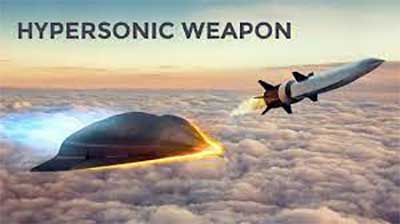GS-3: Defence Technology, Science and technology.
Key words: Hypersonic, Mach, cruise missile, glide missile, scramjet, HSTDV
Why in News:
The U.S. Government has rebuked China vowing to confront its potential military threats in Asia and warning that its pursuit of hypersonic weapons intended to evade U.S. missile defences “increases tensions in the region”.
What is Hypersonic Technology weapon?
The term “hypersonic” describes any speed faster than five times that of sound i.e. greater than 5 Mach( 1 Mach is speed of sound), which is roughly 760 miles (1,220 kilometers) per hour at sea level. So hypersonic weapon travel at a speed of more than 5 Mach. This is extremely complex technology, which also needs to be able to handle high temperatures, making the hypersonic systems extremely costly.
What are the different kinds of hypersonic weapons?
- There are two main types--glide vehicles and cruise missiles.
- Hypersonic cruise missiles: These are the ones that use rocket or jet propellant through their flight and are regarded as being just faster versions of existing cruise missiles.
- Hypersonic Glide Vehicle (HGV): These missiles first go up into the atmosphere on a conventional rocket before being launched towards their target.
- Most of the attention is focused on the former, which are launched from a rocket before gliding to their target, because of the challenges of achieving hypersonic propulsion of missiles.
- The missiles have engines called scramjets that use the air’s oxygen and produce thrust during their flight, allowing them to cruise at a steady speed and altitude.

Scramjets Engine
- A scramjet engine is an improvement over the ramjet engine as it efficiently operates at hypersonic speeds and allows supersonic combustion. Thus it is known as Supersonic Combustion Ramjet, or Scramjet.
- The speed at which the vehicle moves through the atmosphere causes the air to compress within the inlet. As such, no moving parts are needed in a scramjet, which reduces the weight and the number of failure points in the engine.
Which country has Hypersonic Technology?
China, the U.S., and Russia have the most advanced capabilities, and several other countries are investigating the technology, including India, Japan, Australia, France, Germany and North Korea, which claims to have tested a hypersonic missile.
• Russia: Its Avangard is a glide vehicle launched from an intercontinental ballistic missile and will reportedly carry a nuclear warhead.
• China: Its military conducted possibly two hypersonic weapons tests over the summer, including the launch into space of an orbiting hypersonic weapon capable of carrying a nuclear payload. China conducted a number of successful tests of the DF-17, a medium-range ballistic missile designed to launch hypersonic glide vehicles.
• U.S.A: The U.S. Navy leads the development of a glide vehicle for use across the military branches, while the Air Force is working on an air-launched glider.
• India: Both DRDO and ISRO have developed and tested hypersonic technologies.
India’s development in Hypersonic Technology:
- The Hypersonic Technology Demonstrator Vehicle (HSTDV), which can travel at 6 times the speed of sound, was recently successfully flight-tested by DRDO.
- Additionally, the DRDO inaugurated a Hypersonic Wind Tunnel (HWT) test facility in Hyderabad. It's an enclosed, pressurised vacuum-driven free jet facility that simulates Mach 5 to 12.
- In terms of space assets, India has previously demonstrated its capability with the ASAT test conducted as part of Mission Shakti.
Hypersonic Technology Demonstrator Vehicle (HSTDV)
• The HSTDV is an unmanned scramjet demonstration aircraft for hypersonic speed flight. It is being developed as a carrier vehicle for hypersonic and long-range cruise missiles, and will have multiple civilian applications including the launching of small satellites at low cost. The HSTDV program is being run by the Defence Research and Development Organisation (DRDO)
What’s the significance of hypersonic weapons?
- They are normally defined as fast, low-flying, and highly manoeuvrable weapons designed to be too quick and agile for traditional missile defence systems to detect in time.
- Unlike ballistic missiles, hypersonic weapons don’t follow a predetermined, arched trajectory and can manoeuvre on the way to their destination.
- They are very difficult to counter using existing defences.
Source: The Hindu
Q. Consider the following statements with reference to the Hypersonic weapons:
- These weapon travel at a speed of more than 5 Mach i.e. 5 time speed of light.
- Unlike ballistic missiles, hypersonic weapons don’t follow a predetermined, arched trajectory.
Which of the statement/s given above is/are correct?
a) 1 only
b) 2 only
c) 1 and 2 only
d) Neither 1 nor 2
Ans: B







